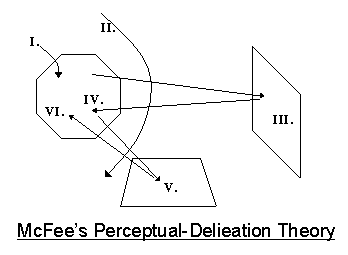Individual Differences in Modes
of Knowing
- cognating
- perceptualizing
- conceptualizing
- manipulating
- transacting
- image making
- verbalizing
- affecting
- communicating
Differences in Cognitive Styles
- analytical-global
- reflective-impulsive
- field dependent-independent
- visual-conceptual memory
Creative Aptitudes
- fluency
- flexibility
- originality
- playfulness
-independence
- openness to perceptions
- intuitive
- feeling
Cultural Effects on Abilities
- kinds of I-spaces and shared spaces
experienced
cultural values toward change, affect
and emotion, art styles
- concepts of what is art
- preferences for order and variety
- preferences for amount of visual detail
- preferences for kinds of space
- preferences for different design elements
Art Development
- drawing dependence on spatial realities
or constancies
- intuitive of analytic modes in using
proximity, similarity, closure, figure and ground, environment |

